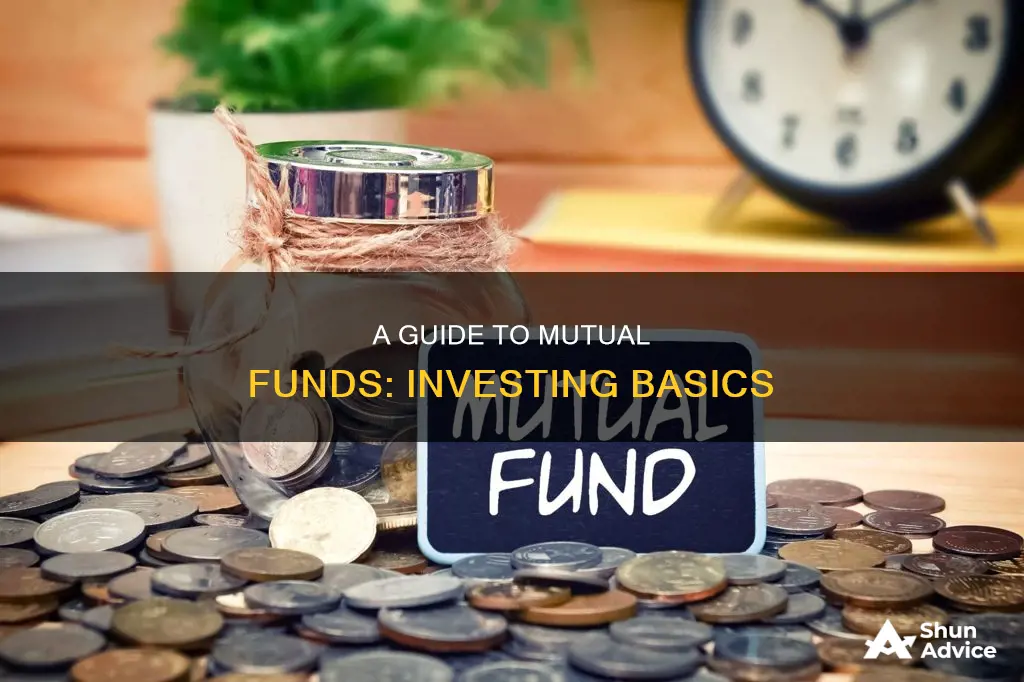
Mutual funds are a popular investment vehicle for those looking to diversify their portfolios. They are a collection of investors' money that fund managers use to invest in stocks, bonds, and other securities. The benefits of investing in mutual funds include diversification, professional management, and relatively low costs. When investing in mutual funds, it is important to consider the fees associated with them, as these will impact your overall returns. There are also different types of mutual funds to choose from, such as stock, bond, money market, and target-date funds. Additionally, mutual funds can be actively or passively managed, which will also impact the returns you earn as an investor.
| Characteristics | Values |
|---|---|
| Definition | Investment vehicle that pools money from multiple investors to purchase a diversified portfolio of stocks, bonds, or other securities |
| Investment Objective | To build a diversified portfolio of stocks, bonds, or short-term investments |
| Benefits | Diversification, professionally managed portfolios, instant diversification, relatively hands-off, relatively low-cost, accessible, good for beginners and experienced investors |
| Downsides | High fees, commissions, and other expenses, lack of transparency, difficulty in comparing funds, large cash presence in portfolios |
| How to Invest | Decide on goals, pick a strategy, research potential funds, open an investment account, purchase shares, set up a plan to keep investing regularly, consider exit strategy |
| Where to Buy | Online brokers, fund managers, employer-sponsored retirement plans |
| Fees | Expense ratios, sales charges or loads, redemption fees, other account fees |
| Types | Active, passive, stock, money market, bond, target-date, index, ESG, sector, theme, international, regional, growth, income, balanced, fixed-income |
What You'll Learn

Active vs. passive funds
One of the biggest distinctions between different mutual funds is whether they pursue an active or passive investment strategy. The difference will determine how the fund invests and can ultimately have a big impact on the returns you earn as an investor.
Active funds
Active funds are managed by professional investors with the goal of outperforming a market index, such as the S&P 500 index. Active investors research and follow companies closely, and buy and sell stocks based on their view of the future. This is a typical approach for professionals or those who can devote a lot of time to research and trading. Active fund managers are buying and selling every day based on their research, trying to ferret out stocks that can beat the market averages. Active funds are therefore suitable for investors who want to try to beat the market and are willing to pay higher fees for professional management.
However, active funds come with larger fees (often around 1% of the fund's assets) to pay for professional management, so the returns to investors are lowered through these types of costs. And while active investing takes a hands-on approach, it is difficult to outperform the market over the long term and on a regular basis. Actively managed funds often fail to match the performance of the index they're trying to beat in the first place.
Passive funds
Passive funds are managed to track the performance of a market index. Passive investors buy a basket of stocks, and buy more or less regularly, regardless of how the market is faring. This approach requires a long-term mindset that disregards the market's daily fluctuations. Passive investors tend to rely on fund managers to ensure the investments held in the funds are performing and expect them to replace declining holdings. Passive funds do not require an expensive investment team to manage the portfolio because they aren't trying to identify the best performers, they're just trying to match the index. This allows passive funds to charge very low fees and sometimes no fees at all, which leaves more of the return for the fund's investors.
While passive funds may sound simple or boring, they have consistently beaten actively managed funds over long time periods. There will always be a few active funds that outperform their benchmark over short time periods, but very few will do so consistently over the long term. Passive investing is also more prevalent among retail investors and has become the strategy of choice for millions of investors who are satisfied by duplicating market returns instead of trying to beat them. Passive funds are therefore suitable for investors who want to match the market and are looking for a quick, easy, and low-cost way to invest.
Money Market Funds: A UK Investor's Guide
You may want to see also

Budgeting for mutual funds
Determine your financial goals and risk tolerance:
Before investing in mutual funds, it is crucial to understand your financial goals and risk tolerance. Are you investing for retirement, saving for a down payment on a house, or pursuing any other financial objective? Different mutual funds offer varying levels of risk and potential returns, so aligning your investments with your goals is essential.
Assess your income and expenses:
Evaluating your financial situation is vital before making any investment decisions. Calculate your after-tax income, including all sources of income, and subtract your essential expenses, such as rent, utilities, groceries, and any existing debt payments. This will give you an idea of how much you can comfortably set aside for investing in mutual funds.
Choose the right type of mutual fund:
There are two main types of mutual funds: active and passive. Active funds are managed by professionals who actively select investments to try to outperform the market. Passive funds, on the other hand, aim to replicate the performance of a particular market index and are often less expensive. Consider your budget and investment strategy when deciding between these options.
Calculate your investing budget:
Mutual funds typically have minimum investment requirements, which can range from $100 to a few thousand dollars. Decide how much you can afford to invest while ensuring that you have enough funds to cover your essential expenses and other financial commitments. Remember that investing in mutual funds should be a long-term strategy, so plan accordingly.
Research and compare different mutual funds:
Before committing to a particular mutual fund, it is essential to research and compare different options. Consider factors such as the fund's historical performance, fees and expenses, investment strategy, and the types of securities it invests in. Evaluating these aspects will help you make an informed decision that aligns with your financial goals and risk tolerance.
Diversify your investments:
Diversification is a crucial aspect of investing. By spreading your investments across different types of mutual funds and asset classes, you can reduce the overall risk of your portfolio. Consider investing in a mix of stock funds, bond funds, and money market funds to balance risk and potential returns.
Monitor and reevaluate your budget:
Investing in mutual funds is not a set-it-and-forget-it strategy. Regularly monitor the performance of your investments and reevaluate your budget to ensure it aligns with your financial goals. As your income, expenses, or life circumstances change, be prepared to adjust your budget and investment allocations accordingly.
Remember, investing in mutual funds involves risk, and there is no guarantee of returns. Always consult a qualified financial advisor to help you make informed decisions based on your specific circumstances.
Smart Strategies for Investing $30,000 in Mutual Funds
You may want to see also

Where to buy mutual funds
Online Brokerages
Online brokerages are a popular choice for buying mutual funds, as they offer a wide range of funds from different fund companies. When choosing an online brokerage, it is important to consider factors such as affordability, fund choices, research and educational tools, and ease of use. Some online brokerages may also offer additional features, such as screening tools or the ability to view all your financial accounts in one place. Examples of online brokerages that offer mutual funds include Fidelity, Charles Schwab, E-Trade, Ally Invest, and J.P. Morgan Self-Directed.
Direct from Fund Company
You can also buy mutual funds directly from the fund company, such as Vanguard or BlackRock. However, this option may limit your choice of funds compared to using an online brokerage.
Traditional Financial Advisor
Another option is to work with a traditional financial advisor to purchase mutual funds, but this may incur additional fees.
Employer-Sponsored Retirement Account
If you contribute to an employer-sponsored retirement account, such as a 401(k), there is a good chance that you are already invested in mutual funds. These accounts can be a convenient way to invest in mutual funds, especially if your employer offers a matching contribution.
Brokerage Account with a Mutual Fund Company
Alternatively, you can open a brokerage account with a mutual fund company, which can also keep costs low. For example, you can buy Fidelity funds from Fidelity Investments, Vanguard funds from The Vanguard Group, and so on.
Short-Term Investment Strategies: Where to Invest Your Money
You may want to see also

Understanding fees
- Expense ratio: This is an annual fee that covers the fund's operating expenses, including management fees, administrative costs, and marketing expenses. It is expressed as a percentage of the fund's average net assets and is deducted from the fund's returns. For example, a 1% expense ratio means you pay $10 for every $1,000 invested. Expense ratios have decreased over the years due to competition from index investing and exchange-traded funds (ETFs). As of 2022, the average expense ratio for equity mutual funds was 0.44%, while bond mutual funds had an average of 0.37%, and hybrid models had an average of 0.59%.
- Sales charges or loads: Some mutual funds charge sales fees, known as "loads," when you buy or sell shares. Front-end loads are charged when you purchase shares, while back-end loads (or contingent deferred sales charges) are assessed if you sell your shares before a certain date. No-load funds, on the other hand, don't charge any sales commissions.
- Redemption fees: Some mutual funds charge a redemption fee when you sell your shares within a short period (usually 30 to 180 days of purchasing them). This fee is designed to discourage short-term trading and is limited to 2% by the U.S. Securities and Exchange Commission (SEC).
- Other account fees: Some funds or brokerage firms may charge additional fees for maintaining your account or transactions, especially if your balance falls below a certain minimum.
- Management and distribution fees: Mutual funds may also charge management fees to pay the fund's managers and investment advisors. Distribution fees, also known as 12b-1 fees, cover the costs of marketing and selling the fund.
It's important to carefully review the fund's prospectus to understand all the fees associated with a particular mutual fund. Fees can vary significantly between different funds, and they can add up over time, impacting your overall investment returns. Therefore, it's crucial to consider fees when deciding which mutual fund to invest in.
Bond Funds: Best Time to Invest and Why
You may want to see also

Managing your portfolio
Rebalancing
It is important to periodically rebalance your portfolio to ensure it aligns with your investment goals and risk tolerance. Typically, this involves adjusting the weightings of different assets or funds within your portfolio to maintain your desired level of diversification. For example, if one part of your portfolio has experienced significant gains and becomes a larger proportion of your portfolio, you may consider selling some of those gains and investing the proceeds in other areas to restore balance. This helps to ensure your portfolio remains aligned with your risk tolerance and investment strategy.
Avoid Chasing Performance
Avoid the temptation to chase performance by buying mutual funds based solely on their recent returns. Remember the cliché, "past performance is no guarantee of future results". Instead, focus on finding funds that align with your long-term investment strategy and goals.
Manage Expectations
Different types of mutual funds will deliver different levels of returns and carry varying levels of risk. For example, stock mutual funds offer higher potential returns but also come with higher risk. In contrast, bond mutual funds provide more stable returns but with lower potential gains. Understanding the expected returns and risk associated with different types of funds will help you manage your expectations and make more informed investment decisions.
Understand Fees
Mutual funds come with various fees that can impact your overall returns. Be sure to understand the fees associated with the funds you invest in, such as expense ratios, sales charges or loads, redemption fees, and account fees. These fees can vary significantly between funds and can eat into your returns over time.
Diversification
One of the benefits of mutual funds is the diversification they offer by pooling your money with other investors to invest in a wide range of securities. However, it is important to ensure your portfolio as a whole is also diversified. Consider investing in different types of mutual funds, such as stock funds, bond funds, and money market funds, to reduce your overall risk and improve long-term returns.
Monitor and Adjust
While mutual funds are typically a long-term investment, it is important to periodically monitor their performance and make adjustments as needed. Review your portfolio at least once a year to ensure it remains aligned with your investment goals and risk tolerance. This may involve buying or selling mutual fund shares to rebalance your portfolio.
Consider a Target-Date Fund
If you want a more hands-off approach to managing your portfolio, consider investing in a target-date fund. These funds automatically adjust their asset allocation over time, becoming more conservative as you approach your target retirement date. This can help take the stress out of managing your portfolio and ensure your investments remain appropriate for your time horizon.
Liquid Fund Investment: A Beginner's Guide to Getting Started
You may want to see also
Frequently asked questions
Mutual funds are a collection of investors' money that fund managers use to invest in stocks, bonds, and other securities. They are a practical, cost-efficient way to build a diversified portfolio.
When choosing a mutual fund, consider whether the fund's investment objectives align with your long-term financial plan. Also, research the fund's overall approach, investing philosophy, and portfolio managers. Additionally, understand the fees associated with the fund, as these can impact your returns over time.
You can buy mutual funds through online brokers or directly from the fund manager. However, buying directly from the fund manager may limit your choices. Most mutual funds have a minimum investment requirement, which can range from $500 to a few thousand dollars.
Mutual funds offer instant diversification, professional management, and relatively low costs. They are also highly liquid, making them easy to buy or sell. Additionally, mutual funds provide access to a wide range of investments, which can help reduce investment risk.







